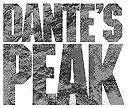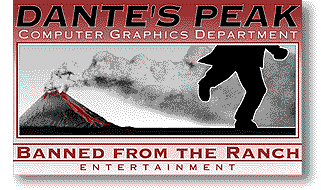 |

Creation and On-Set Supervision of
Computer Graphics Displays |

|
About Our Work
Based upon our work on TWISTER, BFTR was asked to create the screens for DANTE'S PEAK. Once
again, such displays and hardware would not be mere window dressing
--they would literally stand in for the film's immutable and mostly
silent antagonist. The pulse of the volcano had to be monitored
and revealed through the graphics; the screens were the primary
way in which the character of the volcano had to show itself --at
least until the big eruption occurs.
One of the main things we
needed to do for the show was create graphics to reveal what was
happening underground --which is where all the buildup to the
eruption was going on. There had to be that tension for the audience,
actually seeing the magma level rising and the pressure building
--but obviously, the movie couldn't suddenly cut to the actual
interior of the mountain to reveal that. By monitoring the vital
signs of the volcano --seismometry, gas emissions, etc.-- the
way real volcanologists do through these kinds of graphics, the
audience would be able to get the full suspense out of the story.
People watching the movie saw little wavy lines moving on a monitor
and needles rising on a piece of equipment and even though they
didn't know exactly what it meant, they knew it meant trouble
was coming.
 A mandate that had come down from both Roger Donaldson and Gale
Anne Hurd was that DANTE'S PEAK remain as fact-based and scientifically
sound as possible within the realm of dramatic presentation, and
to that end Van and Casey embarked on research excursions to gather
information on the subject; this educational process was and is
half the fun of doing the graphics. A mandate that had come down from both Roger Donaldson and Gale
Anne Hurd was that DANTE'S PEAK remain as fact-based and scientifically
sound as possible within the realm of dramatic presentation, and
to that end Van and Casey embarked on research excursions to gather
information on the subject; this educational process was and is
half the fun of doing the graphics.
Van took the excuse to fly out to Hawaii, where he checked out
the setup at the Hawaii Volcano Observatory on Mt. Kilauea and
walked the still-dangerous lava flows with
one of the production's volcanology consultants, Jack Lockwood.
Jack was a former member of the U.S. Geological Survey's group
of expert volcanologists, and his company, Geohazards Consultants International (GCI), is in the business of checking out volcanic activity around
the world and assisting various agencies in the handling eruptions
and their consequences. He and his fellow consultants on the film
--Norm McLeod and David Harlow of the Cascades Volcano Observatory in Vancouver, Washington-- were understandably concerned about
their professional reputations and the portrayal of the USGS,
and had already turned down working on Fox's "Volcano" due to
the impossibility of the storyline.
We at BFTR thus had to help
be the bridge between the production and the volcanology community,
trying to help both the filmmakers and the real scientists feel comfortable
with working together on the film. Sometimes, a film production
company may hire a token consultant only to be able to say that
 they had a technical expert on the film, but not listen to what
they say; other times, a consultant can piss off a production
simply because in the interest of scientific accuracy they fail
to think narratively. In either case, everybody loses, especially
the film itself.
they had a technical expert on the film, but not listen to what
they say; other times, a consultant can piss off a production
simply because in the interest of scientific accuracy they fail
to think narratively. In either case, everybody loses, especially
the film itself.
Fortunately, director Roger Donaldson was an amateur geologist
and really hit it off with Jack, Norm and David, and the trio
were story-savvy enough to help us all find the most dramatic
way to get the scenes across and still make scientific sense.
For instance, Jack suggested the manner in which Pierce Brosnan's
character demonstrates the functioning of the seismometer by stamping
on the ground, and Roger had the scene rewritten to incorporate
the action.
For our part, we at BFTR tried to insure that all
of our research was incorporated into the graphics, so that hopefully
any volcanologist who went to see the film could not only say
that the film got it right, but would say, "man, I wish we had
that software!" In fact, Carl Johnson, another Hawaii-based volcanologist
and programmer who walked to lava flows with us, wrote a seismic
wave generator for us to use in our graphics in exchange for his
being able to use our interface designs as a basis for some real
software!
Casey and Van traveled up to Vancouver, Washington, to check out
the CVO, and then went on a field trip through the Cascades with Jack
and Norm, ending our trip in Wallace, Idaho, where the film was
 shooting its location work. There, we helped introduce the pair
to the production. On the basis of these meetings and our research
together, Jack and Norm were able to secure official USGS endorsement for the film.
shooting its location work. There, we helped introduce the pair
to the production. On the basis of these meetings and our research
together, Jack and Norm were able to secure official USGS endorsement for the film.
Upon our return to Los Angeles, we started designing and building
graphics. Van designed the screens while tech supervisor Josh
Kirschenbaum animated elements, with digital artist Allen Manning
creating a series of 3D elements for the displays. Meanwhile,
on-set supervisor Glenn Cannon and coordinator Gail Wise set up
shop and wrangled our computer equipment on location to do the
playback on set, and BFTR editorial supervisor Lauryl Duplechan
prepared video elements for playback in the non-computer-related
scenes.
One of the key gags in the script was the use of a walking machine
called "SpiderLegs," which was based upon a real device called
Dante II which was used to walk into a volcano in Alaska. Not only did
we have to design screens to show the characters remotely operating
SpiderLegs, we had to display the feeds from its video cameras
on the computer as well. Most of the video footage as seen from
SpiderLegs' POV was shot separately from the rest of the scenes,
but from the actual lipstick camera mounted on the motorized walking
prop built by floor effects supervisor Roy Arbogast and his team.
In one instance, the selected video take was shot simultaneously
with the live action where the characters are all standing around
the device as they put it through its paces, and we had to paint
out the lights and flags and crew members visible in the shot
before we could incorporate it into our graphics!
One other noteworthy item on the show was the use of Sprint's DRUMS
technology that allowed BFTR, Digital Domain and Universal Studios to videolink directly with the production
on location. This not only proved to be a useful way for Roger
to talk with the folks at DD who were working on the visual effects,
but it also allowed us to incorporate the technology into the
story via the graphics, since the idea was that the film's field
observatory in the Clusters Motel room was linked to the big Cascades
observatory.
Multimedia
Our Credits

DANTE'S PEAK
Screen Graphics and On Set Supervision by
BANNED FROM THE RANCH ENTERTAINMENT |
|
Computer Graphics Supervisor
VAN LING
Computer Graphics Producer
CASEY CANNON
Technical Supervisor
JOSH KIRSCHENBAUM
|
On-Set Technician
GLENN CANNON
Digital Artist
ALLEN MANNING
Coordinator
GAIL WISE
Flatpanel Display Consultant
DAN EVANICKY
|
Video Editor
LAURYL DUPLECHAN
Volcanology Consultants
JACK LOCKWOOD
NORM McLEOD
DAVID HARLOW
CARL JOHNSON
|
Special Thanks to:
Cyrus Smith, Matt Hoffman, Jay Roth, Wes Rubinstein, John Lima, Hitoshi Inoue
|
|
Resources
- Cinefex Magazine, Issue 69, covers the visual effects of DANTE'S PEAK, as well as THE RELIC and STAR TREK: FIRST CONTACT. Call (800) 434-3339 for back issues and subscription information.
- VFX HQ's coverage
of DANTE'S PEAK contains a review of the visual effects from the film, provided by Digital Domain and other houses. http://www.vfxhq.com/1997/relic.html

DANTE'S PEAK on Home Video.
Pick up one of four versions on LaserDisc and DVD from AMAZON.COM.:
- DANTE'S PEAK, Signature Collection LaserDisc
- DANTE'S PEAK, DVD (Snap Case)
- DANTE'S PEAK, DVD (Jewel Case)
Universal Pictures, the studio behind the feature film release. http://www.universalpictures.com
Hawaiian Volcano Observatory, an informative website covering the activity of various Hawaiian volcanoes. http://hvo.wr.usgs.gov/
Jack Lockwood, one of BFTR's volcano advisors. http://www.volcanologist.com/
Cascades Volcano Observatory, a comprehensive site, which includes a section on the frequently asked questions concerning DANTE'S PEAK. http://vulcan.wr.usgs.gov/
Dante II Frame Walking Robot, the real-life walking robot developed by NASA, which was the basis for the film's "SpiderLegs" robot. http://img.arc.nasa.gov/dante/dante.html
Digital Domain, the primary effects house reponsible for DANTE'S PEAK's visual effects. http://www.d2.com

Banned From The Ranch Entertainment Home Page
����General Information: info@bftr.com
|

